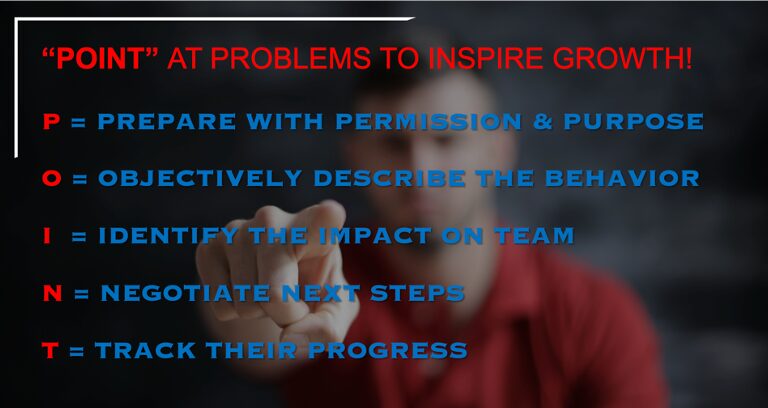One of the most difficult parts of any team leader’s job is to have positive and effective feedback conversations.
If you want to improve your retention or results as a leader, you understand that part of your job is to address behaviors that affect your team performance…
“THE SUREST WAY TO LOSE GREAT EMPLOYEES
IS TO CONSISTENTLY TOLERATE BAD ONES”
And those important conversation are far more effective when you have a 5-part feedback model to use as a structure for your comments…
Whether you are a coach, a sales manager, a school administrator, or a medical staff supervisor, The POINT model provides you a template for having feedback conversations that work and include 5 essential elements of effective feedback

But before you attempt to apply the model to your situation, be reminded that feedback is something that is best delivered in a timely fashion, and should be intended to help your team members grow.
Effective leaders and winning teammates “POINT” at the issue or behavior while still appreciating and encouraging the person!
Feedback is not punishment; it is information and encouragement to improve…
(winning teammates focus on the next play!)
And ANY tough conversation topic will be easier to navigate if you have invested time in building a relationship beforehand (here is a ten-cent secret to do exactly that!)
People are much less defensive when they know that you are aware of their challenges, interested in their growth, and appreciative of their efforts.
So… here is the POINT feedback model:
P = PERMISSION AND PURPOSE
First, ask if they are open to accepting your gift – meet with them individually and share the purpose of your conversation and your intent to help them accomplish their goals.
O = OBJECTIVELY DESCRIBE THE BEHAVIOR
Second, share factual descriptions of their behavior. It is important to be as specific as you can and to the point. DO not waste time with dancing around the issue… just give them the numbers or observed behavior that needs to be addressed.
I = IDENTIFY THE IMPACT ON TEAM
Third, clarify the impact their actions had on the team to inspire empathy. How did the client or coworker feel or react? What is the effect their actions had on others on team members or on clients? This can be either positive or negative!
N = NEGOTIATE NEXT STEPS
Fourth, suggest or ask for their ideas on what could / should be done differently in the future. Remain encouraging and focused on being more effective and ask for their input on what might need to happen to successfully “focus on the next play”
T = TRACK THEIR PROGRESS
Finally, set a date to follow up on the conversation where you can discuss their progress and how things are going… Be sure to acknowledge positive changes in behavior with a “Thank you”, or talk through a new plan to get the results you need.
Ready to try the POINT feedback conversation model?

Try the POINT feedback conversation model to help when you talk with your team about opportunities for growth and improvement…
Here are a few POINT conversation examples:
the + is for positive feedback
the – is for negative feedback conversations
P = PERMISSION AND PURPOSE
+ “You have worked hard recently to grow our advertising income, and I have noticed something that I think you can do to improve those results…”
– “I know one of your personal goals is to be a project leader, and if you are open to it I’d love to share something I think would be helpful…”
O = OBJECTIVELY DESCRIBE THE BEHAVIOR
+ “According to our last quarter’s results, you and your team have successfully added over 30% of advertising from each client!”
– “This week you showed up late to two of our team meetings…”
I = IDENTIFY THE IMPACT ON TEAM
+ “This will create the budget we need to increase our compensation plan and even offer a few more new product lines…”
– “When you don’t arrive on time, it sends the message to others that either you don’t think it is important, or that you don’t respect their time…”
N = NEGOTIATE NEXT STEPS
+ “I think it would be terrific to have you outline some of the specific things you did to accomplish that – our other associates could benefit from those ideas.”
– “So, I’d like to have you commit to being there a few minutes early at our next few meetings. How do you think we can make sure that happens?
T = TRACK THEIR PROGRESS
+ “One month ago you shared your best practices, and now all our team sales are up!”
– “For the last two weeks you have been both early and prepared for our meetings, and I want you to know how much I appreciate that…”
The most effective leaders are those who figure out the positive impact of having feedback conversations… both positive and negative!

– – – – –
Sean Glaze is an author and leadership expert who has worked with clients like Cisco, John Deere, Coca-Cola, and Emory University to increase collaboration, boost productivity, and build exceptional workplace cultures.
Deere, Coca-Cola, and Emory University to increase collaboration, boost productivity, and build exceptional workplace cultures.
As a successful basketball coach and educator for over 20 years, Sean gained valuable insights into leading winning teams – and now he travels around the country to share those lessons…
Sean’s engaging conference keynotes and interactive team building events help accelerate the growth of more effective leaders.
And Sean’s books, Rapid Teamwork, The 10 Commandments of Winning Teammates, and Staying Coachable are entertaining parables with powerful take-aways to improve team performance and leadership!

